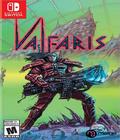Buy Valfaris
A few years ago, Steel Mantis debuted a game, Slain. It had style, but the title was so imbalanced and poorly accepted that the team went back, made lots of fixes, and released the game again as Slain: Back From Hell. While not a complete turnaround, it was enough of an improvement to garner a cult audience, and everyone saw that the team had the potential to do something better. Valfaris is the next game, and while it isn't perfect, it shows off the team's talent in a more positive light.
Story-wise, Valfaris has the setup of a 16-bit era title that wanted to be edgy. You play the role of Therion, a man who's on his way home to the planet of Valfaris, and he's accompanied by his AI companion Hekate. His home has suddenly reappeared with a hellish theme, and he suspects that his father is behind it, so he heads to the planet to investigate.
Like Slain, Valfaris is a pretty linear platformer. It is omnidirectional, so there's more than just going left and right, but don't expect a big side-scrolling, open-world adventure. You're fairly nimble, as you can duck, climb ladders, and scurry below wires and vines, but you can't perform any dodge-rolls to avoid enemy hits. To compensate, you can bring up a shield that can deflect enemy fire if you time it well. Otherwise, your arsenal starts with a basic pistol with infinite ammo, a sword that can refill your shield energy, and a secondary heavier weapon that uses up the same energy for ammo. You can collect Blood Metals to power up your arsenal, but you'll also get newer weapons, like rocket launchers and whips and shotguns, albeit with more heavy metal-inspired names. There is no way to redistribute those weapon upgrades if you invest Blood Metals, so if you want a balanced loadout, you likely won't max out any one weapon.
Aside from the guns, this sounds suspiciously like the team's last game, but there are a few things that make this a better experience. The first is that Valfaris does a better job of teaching the fundamental balance between all of the weapons. The sidearm is self-explanatory, but having to determine when to use the heavy weapons and shields is fundamental when it comes to being efficient with those tools, and using melee to recharge that energy teaches players to mix up their play style.
The art of balance also comes into play when it comes to checkpoints. One thing people will be grateful for is that the checkpoints are more numerous this time around, so you'll encounter them quite often. However, the checkpoints require special pick-ups to use, and this is requires some thought, since picking up the tokens means an increase in health and power until they're used to activate checkpoints. You'll constantly ask yourself if you want to risk getting enough tokens for a permanent upgrade in the hopes that you won't die and trek through the landscape again, or if you want that safety net in exchange for fighting smarter so you won't die as often. This kind of choice is rare in this genre, so it's refreshing to see this gameplay mechanic in place.
Finally, the difficulty level isn't as high as in the team's prior outing. There are plenty of challenging boss fights, and encounters with regular foes can be troublesome if you aren't paying attention, but the aforementioned increase in checkpoints helps make the game feel fair in terms of dying and retracing your steps for every battle. The placement and strength of the enemies also feel toned down, so you can survive a few hits before having to use those checkpoints. The sense of balance only seems to falter in the second half of the game, when the enemy hordes respawn faster and are more numerous, causing that dreaded difficulty spike to occur sharply, but at least it comes at a time when the player has already mastered some skills rather than when they're just learning the basics.
The graphics are reminiscent of later 16-bit titles like Blackthorne thanks to some very detailed pixel work. The rough edges are more of an aesthetic choice, but when combined with the expanded color output and the use of lighting in appropriate places, you have a gorgeous-looking world filled with twisted, organic-looking machinery and buckets of blood. Except for the facial animation in the title screen, everything else looks great in motion, with some special emphasis on the headbanging when you acquire a new weapon. Whether running the game docked or in portable mode, you won't find anything going wrong with the performance. The only complaint might come from the fact that it can sometimes be difficult to tell which parts are in the background and which parts can be interacted with, something that gets easier to decipher in later stages but can initially be confusing.
Audio-wise, the game continues the heavy metal theme. With tons of guitars and bass, each track emphasizes the constant action while also making things feel like their own hard rock music video. The sound effects also do a terrific job of accentuating the action, a big plus since the game features no voices, except for your occasional grunts at getting injured and the death cries of slain enemies.
Valfaris is solid. The pacing is great, and with the exception of the back half, the difficulty curve isn't too bad. The juggling of weapons in relation to their balance is well done, and the constant boss fights are a fulfilling challenge once you overcome each foe. Provided you enjoy the Nintendo-hard games of the past, Valfaris is well worth checking out.
Score: 8.0/10
More articles about Valfaris










 Valfaris is a heavy metal infused 2D action-platformer.
Valfaris is a heavy metal infused 2D action-platformer.































